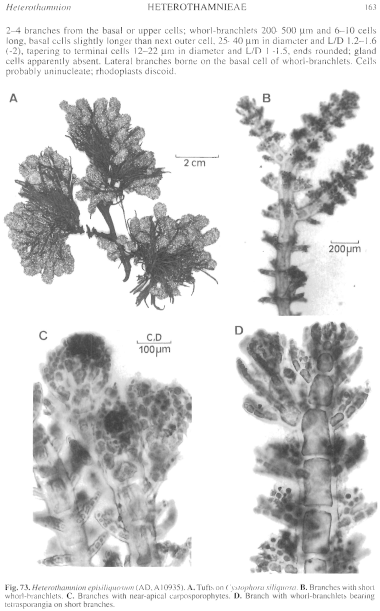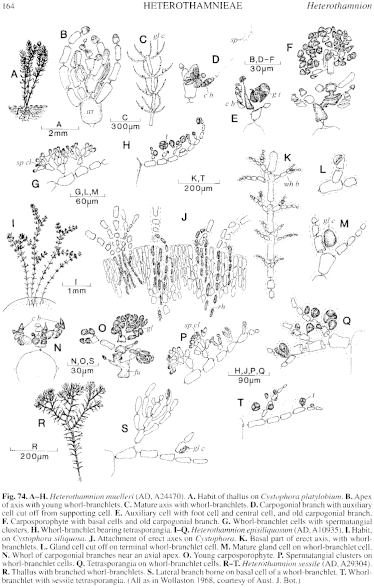|
|
|
|
|
|||||||||||
|
Electronic Flora of South Australia Species Fact Sheet
Phylum Rhodophyta – Order Ceramiales – Family Ceramiaceae – Tribe Heterothamnieae
Selected citations: Athanasiadis 1996: 185, fig. 93.
Thallus (Fig. 73A, 74I) densely tufted, 2–5 mm high, with several to many axes from the base, each axial cell bearing 4 whorl-branchlets. Attachment by clumps of slender basal rhizoids (Fig. 74J), from which further axes arise, penetrating the host; epiphytic on Cystophora siliquosa. Structure. Apical cells 5–6 µm in diameter and L/D 1–1.5, closely surrounded by young whorl-branchlets, enlarging rapidly to axial cells 70–100 µm in diameter and L/D (1) 1.5–2, tapering and shorter towards the base. Whorl-branchlets rigid (Fig. 73B, 74K), 90–160 µm and (3–) 4–6 cells long, upwardly curved when young, horizontal or downwardly curved when older, often with 1–2 (–5) simple branches from the basal or mid cells; basal cells slightly longer than next outer cell, 25–35 µm in diameter and L/D 1–1.5, tapering to terminal cells 18–22 µm in diameter and L/D 1–1.2; gland cells (Fig. 74L, M) lateral, usually on terminal or subterminal cells of the whorl-branchlets, touching the bearing cell and often partly the next cell, ovoid, 20–25 µm in diameter, sometimes with a smaller lateral gland cell. Lateral branches arising on the basal cells of whorl-branchlets. Cells uninucleate; rhodoplasts discoid to elongate.
Reproduction: Gametophytes dioecious. Procarps (Fig. 74N) occur in whorls of 1–4 on the third axial cell at branch apices, each carpogonial branch on a supporting cell which bears a small sterile cell. Post fertilization fusion occurs between the axial cell, foot cell and central cell and a terminal gonimolobe (Figs 73C, 74O), followed by several lateral gonimolobes, develops, with ovoid carposporangia 18–22 in diameter, not protected by lower whorl-branchlets. Spermatangia (Fig. 74P) occur terminally on densely branched clusters on rachis cells of whorl-branchlets.
Tetrasporangia (Figs 73D, 74Q) are borne on cells of short branches on whorl-branchlets, ovoid to subspherical, 25–35 µm in diameter, tetrahedrally divided.
Type from Robe, S. Aust., on Cystophora siliquosa, drift (Womersley, 29.viii.1949); holotype and isotypes in AD, A10935.
Selected specimens: (all on Cystophora siliquosa) D'Estrees Bay, Kangaroo I., S. Aust., sublittoral fringe pools ( Womersley, 24.viii.1950; AD, A15442). Pennington Bay, Kangaroo I., S. Aust., reef edge to 3 m (Mitchell, 20.viii.1963; AD, A26992) and sublittoral fringe (Womersley, 9.x.1997; AD, A67292 - "Marine Algae of southern Australia" No. 398). Stinky Bay, Nora Creina, S. Aust., drift (Womersley, 4.ix.1958; AD, A22093). Port MacDonnell, S. Aust., drift (Womersley, 19.viii.1953; AD, Al 8994). Torquay, Vic., drift (Mitchell, 25.viii. 1965; AD, A29527). Point Lonsdale, Vic., drift (Skinner, 13.xi.1977; AD, A48840).
Distribution: D'Estrees Bay, Kangaroo I., S. Aust., to Cape Shanck, Victoria.
References:
ATHANASIADIS, A. (1996). Morphology and classification of the Ceramioideae (Rhodophyta) based on phylogenetic principles. Opera Botanica No. 128, pp. 1–216.
WOLLASTON, E.M. (1968).Morphology and taxonomy of southern Australian genera of Crouanieae Schmitz (Ceramiaceae, Rhodophyta). Aust. J. Bot. 16, 217–417.
The Marine Benthic Flora of Southern Australia Part IIIC complete list of references.
Publication:
Womersley, H.B.S. (24 December, 1998)
The Marine Benthic Flora of Southern Australia
Rhodophyta. Part IIIC. Ceramiales – Ceramiaceae, Dasyaceae
©State Herbarium of South Australia, Government of South Australia
Illustrations in Womersley Part IIIA, 1998: FIGS 73, 74 I–Q.

Figure 73 enlarge
Fig. 73. Heterothamnion episiliquosum (AD, A 10935). A. Tufts on Cystophora siliquosa. B. Branches with short whorl-branchlets. C. Branches with near-apical carposporophytes. D. Branch with whorl-branchlets bearing tetrasporangia on short branches.

Figure 74 enlarge
Fig. 74. A–H. Heterothamnion muelleri (AD, A24470). A. Habit of thall us on Cystophora platylobium. B. Apex of axis with young whorl-branchlets. C. Mature axis with whorl-branchlets. D. Carpogonial branch with auxiliary cell cut off from supporting cell. E. Auxiliary cell with foot cell and central cell, and old carpogonial branch. F. Carposporophyte with basal cells and old carpogonial branch. G. Whorl-branchlet cells with spermatangial clusters. H. Whorl-branchlet bearing tetrasporangia. I–Q. Heterothamnion episiliquosum (AD, A10935). I. Habit, on Cystophora siliquosa. J. Attachment of erect axes on Cystophora. K. Basal part of erect axis, with whorl-branchlets. L. Gland cell cut off on terminal whorl-branchlet cell. M. Mature gland cell on whorl-branchlet cell. N. Whorl of carpogonial branches near an axial apex. O. Young carposporophyte. P. Spermatangial clusters on whorl-branchlet cells. Q. Tetrasporangia on whorl-branchlet cells. R–T. Heterothamnion sessile (AD, A29304). R. Thallus with branched whorl-branchlets. S. Lateral branch borne on basal cell of a whorl-branchlet. T. Whorl-branchlet with sessile tetrasporangia. (All as in Wollaston 1968, courtesy of Aust. J. Bot.)

|
Email Contact: State Herbarium of South Australia |

|